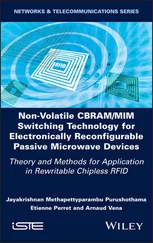Joel P. Dunsmore - Handbook of Microwave Component Measurements
Здесь есть возможность читать онлайн «Joel P. Dunsmore - Handbook of Microwave Component Measurements» — ознакомительный отрывок электронной книги совершенно бесплатно, а после прочтения отрывка купить полную версию. В некоторых случаях можно слушать аудио, скачать через торрент в формате fb2 и присутствует краткое содержание. Жанр: unrecognised, на английском языке. Описание произведения, (предисловие) а так же отзывы посетителей доступны на портале библиотеки ЛибКат.
- Название:Handbook of Microwave Component Measurements
- Автор:
- Жанр:
- Год:неизвестен
- ISBN:нет данных
- Рейтинг книги:5 / 5. Голосов: 1
-
Избранное:Добавить в избранное
- Отзывы:
-
Ваша оценка:
- 100
- 1
- 2
- 3
- 4
- 5
Handbook of Microwave Component Measurements: краткое содержание, описание и аннотация
Предлагаем к чтению аннотацию, описание, краткое содержание или предисловие (зависит от того, что написал сам автор книги «Handbook of Microwave Component Measurements»). Если вы не нашли необходимую информацию о книге — напишите в комментариях, мы постараемся отыскать её.
Handbook of Microwave Component Measurements — читать онлайн ознакомительный отрывок
Ниже представлен текст книги, разбитый по страницам. Система сохранения места последней прочитанной страницы, позволяет с удобством читать онлайн бесплатно книгу «Handbook of Microwave Component Measurements», без необходимости каждый раз заново искать на чём Вы остановились. Поставьте закладку, и сможете в любой момент перейти на страницу, на которой закончили чтение.
Интервал:
Закладка:
The output power amplifiers of vector sources are important as their distortion will directly affect the modulated signal, causing TOI, and the spectral spreading of modulated signals.
1.15.3 Spectrum Analyzers
A spectrum analyzer (SA) is a specialized type of receiver, which displays the power of a signal on the y‐axis versus the frequency of the signal on the x‐axis. As such, it could be considered a frequency‐sensitive power meter.
The key attributes of a spectrum analyzer are its displayed average noise level (DANL) and its maximum input power. The maximum input is set by the compression of the input mixer in the SA and can be increased by adding input attenuation. However, adding attenuation degrades the DANL by an equal amount. A further limitation in measuring signals, for example, TOI, is the self‐generated distortion of the input mixer, which will generate TOI signals at the same frequencies as that as the TOI from the signal under test. The data sheet for an SA will typically specify the distortion in dBc relative to some input level at the mixer. This, coupled with the noise floor, will set the measurement range of the SA. Lower‐resolution bandwidth will lower the noise floor at the cost of speed of measurement. Similar effects are present for the measurement of harmonics.
Another key attribute of a spectrum analyzer is its frequency flatness and power linearity specifications. Flatness specifications of a spectrum analyzer are usually quite large, as much as ±2.0 dB for 26 GHz microwave version, although typical performance is much better, and this flatness can be compensated for with an amplitude calibration. Microwave and mm‐wave systems can be even worse. The large value for frequency response comes from the interactions of the pre‐selector (which is usually a swept YIG filter) and the first converter in the SA. To a first order, these are stable and can be corrected for, but there will still be a residual flatness error even after calibration related to the post‐tuning drift of the pre‐selector; that is, it does not always tune its peak value to the same frequency for the same settings. Another source of uncorrected error is the mismatch between the SA input and the output match of the signal source being measured. In some cases, this can be a quite high number, up to ±1 dB or more.
As the name implies, the key role of spectrum analyzers is in determining the quality of unknown spectrums. The use of spectrum analyzers in microwave component test applications is primarily as a means to the frequency response or distortion response of a system as a known stimulus is applied.
In recent times, these applications of spectrum analyzers are being augmented by advanced VNAs, which have higher‐speed receivers, built‐in sources, and advanced calibration capabilities, as well as PXI‐based spectrum analyzers. Spectrum analyzers are available in modular (PXI) formats and can be configured as multi‐channel spectrum analyzers. Further, some spectrum analysis has moved into the mm‐wave range, typically with external down‐converters, but some manufacturers are producing spectrum analyzers with internal mm‐wave converters to provide broadband (up to 110 GHz) capabilities. These newer implementations may not have hardware preselection for image rejection, but rather use advanced forms of digital image‐rejection based on high‐speed FFT processing or other methods. More about this appears in Chapter 8.
1.15.4 Vector Signal Analyzers
With the advent of digitally modulated signals for RF and microwave communications, spectrum analyzers have evolved into much more complex systems that include the ability to do wideband de‐modulation of these signals. These specialized spectrum analyzers are often called vector signal analyzer s (VSAs) and play an important role in component tests.
For many active components, a key figure of merit is the distortion that they apply to the vector modulated signal in the form of amplitude or phase error relative to an ideal signal. The composite of all errors over a set of digital symbols is called the error vector , and the average magnitude of this error is the error‐vector‐magnitude (EVM). While EVM is a signal figure of merit, as it is compared to an ideal waveform, the EVM from an amplifier is a combination of the EVM of the input signal and the errors added by the amplifier. From this it is clear that EVM is not a microwave‐component parameter; but a related value, residual or added EVM, is and is described as the EVM at the output signal relative to the input signal. In practice, high‐quality sources are used to produce the digitally modulated signals, so the input effect on EVM is small, but with higher data rates and wider bandwidths of modulation, these input effects are becoming more important. Thus, there is a need for a multi‐channel VSA that can compare input to output signals. A normal SA with a VSA capability does not provide such dual‐channel capability, but some manufacturers supply a specialized dual‐channel receiver for the VSA, while other implementations of a VSA use a wideband digitizer, or even a digital oscilloscope, to do direct digitization of the modulated signal. To date, up to four simultaneous channels have been reported in such a VSA.
1.15.5 Noise Figure Analyzers
An offshoot of a spectrum analyzer, a noise figure analyzer (NFA) is a specialized test instrument that is designed particularly for measuring noise figure. NFAs started out as specialized spectrum analyzers, with improvements in the quality of the receiver and with electronically switched gains to allow the noise figure of the test equipment to be minimized relative to the signal being measured. Some of the things needed to accomplish this, such as adding high‐gain LNAs in front of the first converter, reduced the maximum input power of the instrument so that it was no longer suitable for general‐purpose SA applications.
On the other hand, several spectrum analyzer manufacturers have added a noise figure personality to their SA offerings so that there is quite a lot of overlap between the capabilities of the two systems. However, most SA implementations require the use of an added LNA, at least over some of the band. Newer SAs have an IF structure almost as flexible as an NFA to optimize the performance of the system.
All of these systems of NFA utilize the “hot/cold” or “Y‐factor” method of measuring noise figure (more about this in Chapter 9) using as an input to the DUT a noise source that can be turned on and off. From careful measurement of the output noise, the gain and noise figure of the DUT can be discerned.
More recently, VNAs have been modified to operate as NFAs, utilizing an entirely different technique called the cold‐noise method. In this method, the output noise power is measured, along with the gain using the normal VNA measurement of gain, and the noise figure is computed from these values. No noise source is used in the measurement. This has an advantage of being faster (only one noise measurement is needed) but does have the disadvantage of being sensitive to drift in the gain of the VNA noise receiver. The Y‐factor method does not depend upon the gain of the NFA receiver, but this advantage is often offset by the fact that the gain measurements of the NFA are sensitive to match errors as are the noise measurements, and these are not compensated for.
The ultimate in noise figure analysis is a noise parameter test system. This system properly accounts for all mismatch effects. Some systems use both a VNA and an NFA to measure the gain and noise power, respectively. All noise parameter systems include an input impedance tuner to characterize the change in noise power versus impedance value. Recently, tuners have been combined with VNA‐based NFAs to produce compact, high‐speed noise parameter test systems. These newer systems provide the ultimate in speed and accuracy available today.
Читать дальшеИнтервал:
Закладка:
Похожие книги на «Handbook of Microwave Component Measurements»
Представляем Вашему вниманию похожие книги на «Handbook of Microwave Component Measurements» списком для выбора. Мы отобрали схожую по названию и смыслу литературу в надежде предоставить читателям больше вариантов отыскать новые, интересные, ещё непрочитанные произведения.
Обсуждение, отзывы о книге «Handbook of Microwave Component Measurements» и просто собственные мнения читателей. Оставьте ваши комментарии, напишите, что Вы думаете о произведении, его смысле или главных героях. Укажите что конкретно понравилось, а что нет, и почему Вы так считаете.












